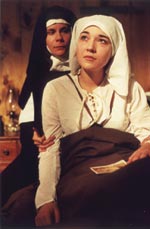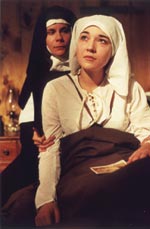A press release describes Thérèse as “one of the first post-Passion projects to meet Hollywood’s newly piqued interest in religious film.” Clearly the producers hope that this is the “right moment” for such a film. And it may be, at least for Roman Catholics, among whom Thérèse of Lisieux (the “Little Flower”) is the most recognizable and popular saint of modern times.
As an evangelical Protestant, however, I felt as I watched this first full-length English-language film portrayal of the young lady of Lisieux that I had somehow wandered into a theater playing a foreign film without subtitles. Something was being communicated just below the surface here, I thought, in telegraphic symbols and catchphrases, but I was too dense to quite catch the deeper meaning. I felt uncomfortable, as if I sat with a sign around my neck reading “clueless Protestant.”

As a student of Christian history with a desire to see more deeply into the many traditional ways of being Christian, I kept hoping I’d be let in on the secret. But the plot, characterization, and dialogue barely skimmed the surfaces—failing to show us why a young girl yearned so deeply to enter a monastery at the age of 15 that she importuned the Pope himself; how she was able to travel from despair at her own lack of heroic sanctity to joy in self-denial and small acts of kindness; and how those who witnessed her death—an agonizing wasting-away from tuberculosis—found redemptive value in her suffering.
In the film’s early frames we meet the tight-knit Martin family at their modest French estate. The father, Louis, is forever reading Scripture to his five daughters. His vocation—never shown in the movie—is that of watchmaker, though he once aspired to be a monk. The Martin sisters move in a relational landscape of perpetual sunny-ness—never a cloud passes over their close, affirming relationships; no impious or mean-spirited word is spoken.

Soon life (God, providence) does heave a heavy stone into this tranquil domestic pond: When Thérèse is just 4 years old, her mother, Zélie, dies prematurely of breast cancer (off camera), leaving the father (played by director Leonardo Defilippis) to soldier on with his brood of five girls. Thérèse is “adopted” by her older sister Sophie, who—after the younger sister is taunted for the unforgivable schoolchild faux pas of raising her hand at will to provide answers nobody else knows—takes up the task of homeschooling her beloved younger sister. But Sophie yearns to enter the Carmelite monastery; she calls it her “secret desert place” in which she will meet with the Lord. This she finally does, leaving Thérèse shattered and weeping the tears she had not seemed able to weep at the death of her (first) mother.
Thérèse then enters a tailspin, descending into a dark and oppressive psychosis. She thrashes on her bed, seemingly beyond all help. But her sisters bring a statue of Mary into her sickroom. It glows with an unearthly light, and Thérèse arises miraculously.
Then one Christmas Thérèse, now 14, has a conversion experience that restores the joy she had missed since her mother’s death. She wants nothing else but to enter the monastery (this is the term used, rather than “convent”—though we see only women within). And after a series of attempts, she is at last accepted at the unheard-of age of 15 and enters Sophie’s “desert place.”
From here, things move rapidly. We see Thérèse enduring patiently the ill-tempered, vindictive treatment of the sour Sister Augustine. We see Thérèse helping an elderly sister to the mess hall, finding joy in the act even as the sister heaps verbal abuse on her. We hear Thérèse’s obliging voice-over (presumably, in the words of the devotional diary we have seen her older, cloistered self writing, at the film’s beginning), explaining patiently to us how she found true sanctity in the little things—the little sacrifices and “crosses”—not in heroics like those of Joan of Arc.

At last the film winds down, lingering lovingly on scenes of a dying Thérèse (now age 24) who, her voice-over tells us, has been experiencing unremitting spiritual darkness for weeks. We see her in brutal close-up, suffering the last stages of tuberculosis, coughing up blood. “Mother,” she asks her superior, “Is this the agony? Am I not going to die?”
“Yes, my poor little one,” answers the older nun. “It is the agony.”
At last she sits up, a mystic strength animating her body, her coughing stilled. Birds begin to sing. She is transfigured by a shining light. (This effect is robbed of cinematic power by the fact that it has already been trotted out several times, after the manner of the classic gold halo in renaissance religious art, to emphasize the beatitude of statues and people alike.)
As the encircling nuns look on in astonishment, the suffering saint speaks one clear phrase. “My God—I love you.” Then she lies back down and dies. The sisters dissolve into awkwardly overacted weeping. They tuck a rose into their dead friend’s hand, snugly, next to the crucifix she still clutches.
The point of this cinematic morality tale (I can hardly call it a biography, let alone a history) is both painfully clear and bewilderingly alien to Protestant sensibilities: the road to intimacy with Jesus must run through renunciation and suffering. The small struggles and untimely death of a cloistered young woman can touch us and show us the way to true sanctity.

I do not doubt that the life of Thérèse has really ministered to people over the years since her death in 1897. But despite the occasional moments of beauty, this film is altogether too heavy-handed in its acting, its story-telling, its music, and its visual effects to carry such a delicate spiritual message very effectively. Stylistically, this movie is bland, colorless, and over-pious. It lacks any of the psychological complexity that would allow us to really understand or sympathize with its main character.
Substantively, it fails to show us why this pious girl has become such a modern favorite. We (or at least I) just don’t get it.
In the end, there is too much here that we must take on faith. Like a series of Victorian tableaux, Thérèse might still carry significant emotional punch—but only through what the viewer is able to read into the film’s parade of set pieces. Unfortunately, unless we—the witnesses to this drawing-room drama—are intimately familiar both with the peculiarities of Roman Catholic piety and with Thérèse’s status as one of the most beloved saints of the modern era, we lack the cultural equipment to do that “reading-in.”
Talk About It
Discussion starters- Most Protestants wouldn’t go to a monastery to draw closer to God, but there is something to be said for finding a “desert place,” away from the distractions of daily life. If you did that, where is that place for you? What would a spiritual retreat look like for you?
- The Bible calls all Christians “saints,” not just a special few. But we can still find inspiration in the lives of other Christians. Does the life of Thérèse inspire you in any way? How?
- Thérèse found a fulfilling life in Jesus by following “the Little Way”—making little sacrifices and doing little kindnesses for others. Where in the Bible do we see something like this described? (Hint: Start with the Sermon on the Mount, Matthew 5-7)
The Family Corner
For parents to considerThere’s nothing particularly objectionable or shocking in this movie. When Thérèse coughs up blood several times at the end of the movie may be disturbing for some younger viewers. And some Protestant viewers may want to discuss with younger family members the healing of Thérèse by (it is strongly implied) the agency of the Virgin Mary.
Chris Armstrong is the managing editor of Christian History & Biography. For more information on Thérèse, check out thesewebsites.
Photos © Copyright Luke Films
What Other Critics Are Saying
compiled by Jeffrey Overstreetfrom Film Forum, 10/28/04Paula Murphy (Godspy) says the film, “though earnest and pious and crafted with great care, perhaps even great love, [is] not so much a movie as a plodding, poorly-scripted catechism of dreadful ‘on-the-nose’ dialogue. Moreover … I couldn’t help but wish that the time, attention, and money that had obviously been spent on getting the furniture right had been otherwise invested on professional actors.”
But Murphy concludes that the biggest flaw runs deeper: “Thérèse is a very pretty movie. The problem … is this: Thérèse Martin’s brief nineteenth century bourgeois life contains little of what one might call ‘cinematic’ value. Therefore, any film about her could be about only one thing: Thérèse’s interior life. Her huge, monstrously huge, interior life. An interior life that was many things, but not pretty.”
Copyright © 2004 Christianity Today. Click for reprint information.












